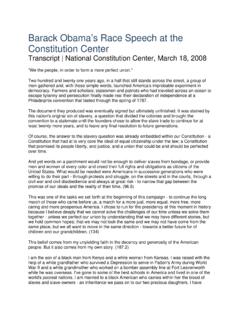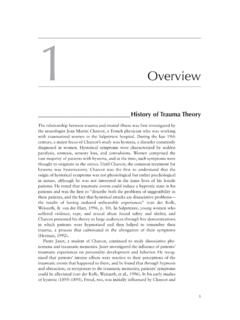Transcription of Common Mental Disorders and Misused Substances
1 JOIN THE VOICES FOR RECOVERY: TOGETHER WE ARE STRONGER. Common Mental Disorders AND Misused Substances . Common Mental . Disorders AND. Misused . Substances . 1. JOIN THE VOICES FOR RECOVERY: JOIN THE VOICES. TOGETHERFOR RECOVERY: WE ARE STRONGER. TOGETHER WE ARE STRONGER. 3 0 Y E A R S. Common Mental Disorders . AND Misused Substances . Each September, the Substance Abuse help countless people start and sustain their and Mental Health Services Administration recovery. (SAMHSA) ( ), within the Department of Health and Mental and Substance Use Human Services (HHS) ( Disorder Prevalence in the gov/), sponsors National Recovery Month United States (Recovery Month) (https://recoverymonth.)
2 Gov). This observance celebrates the millions Millions of people in the live with a Mental of Americans who are in recovery from Mental or substance use disorder, or both. and substance use Disorders , reminding us that According to the National Survey on Drug treatment is efective and that people can and Use and Health (NSDUH), in 2017, an do recover. It also serves to help reduce the estimated million Americans aged 12. stigma and misconceptions that cloud public or older currently used illicit drugs, and understanding of Mental and substance use had used an illicit drug in the past month. Disorders , potentially which discourages others Additionally, about 1 in 4 people aged 12 or from seeking help.
3 Older (or percent of this population). currently binge drank alcohol, and an The 2019 Recovery Month theme, Join estimated million people aged 12 or the Voices for Recovery: Together We Are older had engaged in past-month heavy Stronger, emphasizes the need to share alcohol use. resources and build networks across the country to support the many paths to recovery. In 2017, there were million people, It reminds us that Mental and substance use or percent, aged 12 or older who Disorders afect all of us and that we are all had a substance use disorder in the part of the solution. The Recovery Month past year. observance will highlight inspiring stories to help thousands of people from all walks of life fnd the path to hope, health, and overall million wellness.
4 Adults aged 18 or older had any Mental illness in the past year. During the 30th anniversary of Recovery Month, communities across the nation will refect on In 2017, NSDUH also reported that their positive strides and their plans to make million adults aged 18 or older ( recovery support services more accessible percent) had any Mental illness in the past so people can live meaningful and productive year. 1,2,a lives. Over the years, recovery-oriented organizations have also played an essential role Among adults aged 18 or older, in states, cities, towns, and neighborhoods to million adults ( percent) had a Common Mental Disorders AND Misused Substances | 2.
5 JOIN THE VOICES FOR RECOVERY: TOGETHER WE ARE STRONGER. serious Mental illness (SMI) in the past Other problems often contribute year in ,b to suicide, such as those related to relationships, substance use, physical In 2017, an estimated million health, and job, money, legal, or adults 18 or older reported having co- housing stress. occurring Disorders . This means that within the previous year, they experienced both More than half 54 percent of people any Mental illness and a substance use who died by suicide did not have a known Mental health condition. About percent of individuals aged 18 to 25 ( million) had co-occurring Mental illness and a substance use According to the 2018 Centers for Disease Control and Prevention's (CDC) Vital Signs: 30%.
6 Suicide Rising Across the report, suicide is a leading cause of death in the From 1999 through 2016, suicide rates increased in nearly every state, with half the states increasing by more than 30 percent. In 2016, nearly 45,000 Americans died by Suicide is a leading cause of suicide. The report also found that: death in the From 1999 through 2016, suicide rates increased in nearly Mental health conditions are often seen every state, with half the states as the cause of suicide, but suicide is increasing by more than rarely caused by any single factor. 30 percent. Read on to learn about Common Mental Disorders and Misused Substances ; signs, symptoms, and adverse health efects; additional information on prevalence; and the average age of frst-time use of a substance.
7 To learn more about the most Common Mental and substance use Disorders and how SAMHSA. works to reduce their impact on America's communities, please visit: a A person with any Mental illness (AMI) is defned as an individual having any Mental , behavioral, or emotional disorder in the past year that met Diagnostic and Statistical Manual of Mental Disorders (DSM-IV) criteria (excluding developmental and substance use Disorders ) See: American Psychiatric Association. (1994). Diagnostic and Statistical Manual of Mental Disorders (DSM-IV) (4th ed.). Washington, DC. b A person with serious Mental illness (SMI) is defned as an individual having any Mental , behavioral, or emotional disorder that substantially interfered with or limited one or more major life activities.
8 AMI and SMI are not mutually exclusive categories; adults with SMI are included in estimates of adults with AMI. Common Mental Disorders AND Misused Substances | 3. JOIN THE VOICES FOR RECOVERY: TOGETHER WE ARE STRONGER. Common Mental Disorders . Estimate Surveillance Mental Disorder Signs and Symptoms6 Description System7,8,9,10, Estimate14. 11,12,13. Anxiety Disorders Generalized Excessive anxiety and worry about a Lifetime Prevalence NCS-A of youth Anxiety Disorder variety of events or activities ( , work in the United States or school performance) that occurs Among Youth (13 to 18. more days than not, for at least 6 Years Old). months. People with generalized anxiety Lifetime Prevalence NCS-R of adults disorder fnd it difcult to control their in the United States worry, which may cause impairment in Among Adults social, occupational, or other areas of functioning.
9 Obsessive Uncontrollable, reoccurring thoughts Lifetime Prevalence NCS-R of adults Compulsive (obsessions), and behaviors in the United States Disorder (OCD) (compulsions) that he or she feels the Among Adults urge to repeat over and over. Panic Disorder Unexpected and repeated episodes of Lifetime Prevalence NCS-A of youth intense fear accompanied by physical in the United States symptoms that may include chest pain, Among Youth (13 to 18. heart palpitations, shortness of breath, Years Old). dizziness, or abdominal distress. These Lifetime Prevalence NCS-R of adults episodes occur out of the blue, not in the United States in conjunction with a known fear or Among Adults stressor.
10 Post-Traumatic Can develop after exposure to a Lifetime Prevalence NCS-A of youth Stress Disorder potentially traumatic event that is beyond in the United States a typical stressor. Events that may lead (PTSD) to PTSD include, but are not limited to, Among Youth (13 to 18. violent personal assaults, natural or Years Old). human-caused disasters, accidents, Lifetime Prevalence NCS-R of adults combat, and other forms of violence. in the United States Exposure to events like these is Common . Among Adults About one half of all adults will experience at least one traumatic event in their lives, but most do not develop PTSD. People who experience PTSD may have persistent, frightening thoughts and memories of the event(s), experience sleep problems, feel detached or numb, or may be easily startled.







